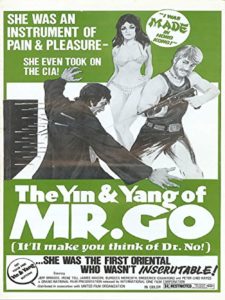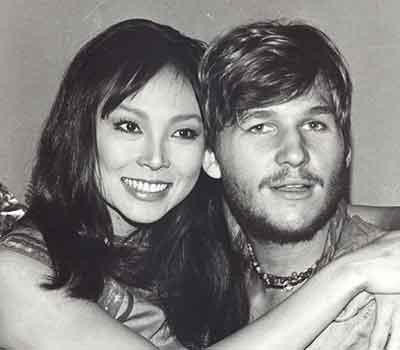 This forgotten 1970 release marks two important debuts: that of the twenty year old “Jeffrey” Bridges, who was “introduced,” and Burgess Meredith, whose first and only solo directorial film credit was THE YIN AND THE YANG OF MR. GO. The intentions of Mr. Meredith, who also wrote the script, were pure: he sought to create a comedic dramatization of a Chinese legend about how every fifty years or so Buddha sends a beam of light from his inner eye that transforms a person into the antithesis of how he or she previously was (Meredith, for the record, was a lifelong Methodist).
This forgotten 1970 release marks two important debuts: that of the twenty year old “Jeffrey” Bridges, who was “introduced,” and Burgess Meredith, whose first and only solo directorial film credit was THE YIN AND THE YANG OF MR. GO. The intentions of Mr. Meredith, who also wrote the script, were pure: he sought to create a comedic dramatization of a Chinese legend about how every fifty years or so Buddha sends a beam of light from his inner eye that transforms a person into the antithesis of how he or she previously was (Meredith, for the record, was a lifelong Methodist).
This forgotten 1970 release marks two important debuts: that of the twenty year old “Jeffrey” Bridges, who was “introduced,” and Burgess Meredith, whose first and only solo directorial film credit was THE YIN AND THE YANG OF MR. GO.
The filming, which took place in Hong Kong, reportedly involved a lot of friction between Meredith and the film’s star James Mason, frequent production shut-downs (during, which, according to Bridges, “we would sit there, not working, for weeks and weeks”) and, unsurprisingly, a great deal of hash smoking. Then, twelve days before completion, one of the producers and his backers cancelled the film and took off with the negatives, never to be seen again—the producer, that is.
…and, unsurprisingly, a great deal of hash smoking.
;
The footage, as it happened, was reconfigured by another of the film’s producers, one Dick Randall, who added narration by Broderick Crawford (who identifies himself as Buddha) and out-of-place animation to fill in the script’s unfilmed portions. Meredith claims he wasn’t aware the film had been completed, much less released, until the eighties, when Bridges discovered a VHS copy. “I figured Buddha had a lot to do with it,” Meredith later stated.
Meredith claims he wasn’t aware the film had been completed, much less released, until the eighties, when Bridges discovered a VHS copy.
Meredith plays a Japanese acupuncturist (Caucasian performers playing Asian roles having been standard practice in 1970) and James Mason one of his patients, the half-Chinese, half-Mexican Yin-Yang Go (a name that telegraphs his arc), an amoral businessman located in Hong Kong. Bridges plays Nero Finnegan, an AWOL soldier who approaches Go to borrow money, a request Go grants, provided Nero agrees to become a prostitute. This he does, and the object of his initial seduction being a gay scientist who Go is seeking to blackmail into revealing the secrets of a high-tech missile system patented by said scientist.

But then, at around the halfway point, Buddha decides to intervene, in the form of a cartoon statue that shoots a beam of light from its forehead that causes Mr. Go, in the middle of a helicopter ride, to suddenly become a nice person. As such he rescues Nero’s prostitute girlfriend (Irene Tsu) from her evil masters, fakes his own death and goes into hiding. The US government, meanwhile, takes to combing Hong Kong for Go’s whereabouts.
That this film is a horrendous misfire is, in light of its history, a given. Scene after scene is cut off before its logical conclusion, and linked quite clumsily by poorly inserted shots of planes landing and scenic montages of characters wandering through Hong Kong, scored via original songs by Marcia Waldorf that seem better suited to 1960s commercial jingles.
In truth, however, the film’s failings can’t all be blamed on the postproduction snafus. The conception of Buddha suddenly enlightening a questionable character in mid-helicopter flight isn’t exactly promising (although it is entirely in keeping with the Hollywood depiction of Buddhism in films like THE GOLDEN CHILD, LITTLE BUDDHA and SEVEN YEARS IN TIBET). Nor is Burgess Meredith above shameless exploitation, as in a lesbian rape scene that drags on far longer than necessary, and an overall portrayal of Eastern culture that’s outdated and, yes, racist (there’s even a gong heard periodically to denote the oriental flavor of the proceedings).
The conception of Buddha suddenly enlightening a questionable character in mid-helicopter flight isn’t exactly promising…
Yet the film, for all its many, many shortcomings, is fun. The comedic touch is deftly utilized and, unlike 99 percent of most 1960s comedies, holds up reasonably well, with THE YIN AND THE YANG OF MR. GO being a rare example of a late-1960s film that comes close to uniting mainstream and counterculture sensibilities. As the final line states, “The beam really works. Who will it strike next time? Well, I have fifty years to worry about that. Perhaps it could even be you!”
Vital Statistics
THE YIN AND THE YANG OF MR. GO (THE THIRD EYE)
Ross Film Productions Limited
Director: Burgess Meredith
Producers: Thomas I. Ross, Dick Randall
Screenplay: Burgess Meredith
Cinematography: John Stephens
Editing: Richard Brockway
Cast: Burgess Meredith, James Mason, Jack McGowran, Jeffrey Bridges, Irene Tsu, Peter Lind Hayes, King Hu, Clarissa Kaye, Gigo Tevzadze, Jay Adler, Broderick Crawford
